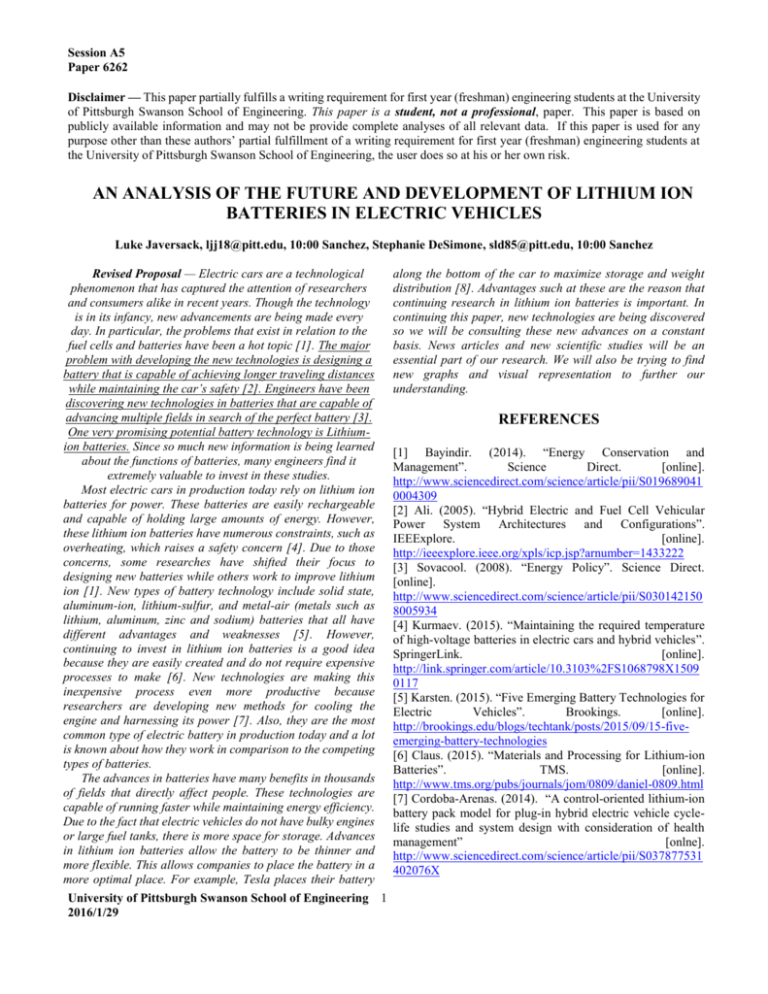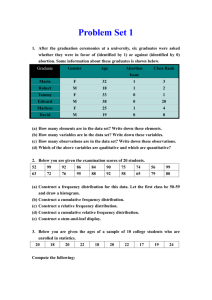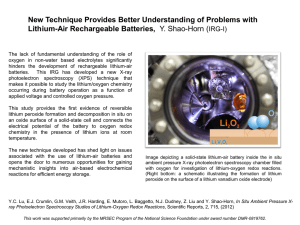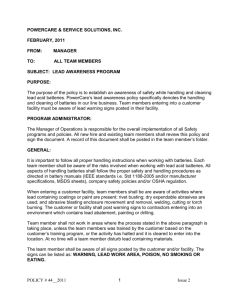an analysis of the effectiveness and future of batteries in electric
advertisement

Session A5 Paper 6262 Disclaimer — This paper partially fulfills a writing requirement for first year (freshman) engineering students at the University of Pittsburgh Swanson School of Engineering. This paper is a student, not a professional, paper. This paper is based on publicly available information and may not be provide complete analyses of all relevant data. If this paper is used for any purpose other than these authors’ partial fulfillment of a writing requirement for first year (freshman) engineering students at the University of Pittsburgh Swanson School of Engineering, the user does so at his or her own risk. AN ANALYSIS OF THE FUTURE AND DEVELOPMENT OF LITHIUM ION BATTERIES IN ELECTRIC VEHICLES Luke Javersack, ljj18@pitt.edu, 10:00 Sanchez, Stephanie DeSimone, sld85@pitt.edu, 10:00 Sanchez Revised Proposal — Electric cars are a technological phenomenon that has captured the attention of researchers and consumers alike in recent years. Though the technology is in its infancy, new advancements are being made every day. In particular, the problems that exist in relation to the fuel cells and batteries have been a hot topic [1]. The major problem with developing the new technologies is designing a battery that is capable of achieving longer traveling distances while maintaining the car’s safety [2]. Engineers have been discovering new technologies in batteries that are capable of advancing multiple fields in search of the perfect battery [3]. One very promising potential battery technology is Lithiumion batteries. Since so much new information is being learned about the functions of batteries, many engineers find it extremely valuable to invest in these studies. Most electric cars in production today rely on lithium ion batteries for power. These batteries are easily rechargeable and capable of holding large amounts of energy. However, these lithium ion batteries have numerous constraints, such as overheating, which raises a safety concern [4]. Due to those concerns, some researches have shifted their focus to designing new batteries while others work to improve lithium ion [1]. New types of battery technology include solid state, aluminum-ion, lithium-sulfur, and metal-air (metals such as lithium, aluminum, zinc and sodium) batteries that all have different advantages and weaknesses [5]. However, continuing to invest in lithium ion batteries is a good idea because they are easily created and do not require expensive processes to make [6]. New technologies are making this inexpensive process even more productive because researchers are developing new methods for cooling the engine and harnessing its power [7]. Also, they are the most common type of electric battery in production today and a lot is known about how they work in comparison to the competing types of batteries. The advances in batteries have many benefits in thousands of fields that directly affect people. These technologies are capable of running faster while maintaining energy efficiency. Due to the fact that electric vehicles do not have bulky engines or large fuel tanks, there is more space for storage. Advances in lithium ion batteries allow the battery to be thinner and more flexible. This allows companies to place the battery in a more optimal place. For example, Tesla places their battery University of Pittsburgh Swanson School of Engineering 1 2016/1/29 along the bottom of the car to maximize storage and weight distribution [8]. Advantages such at these are the reason that continuing research in lithium ion batteries is important. In continuing this paper, new technologies are being discovered so we will be consulting these new advances on a constant basis. News articles and new scientific studies will be an essential part of our research. We will also be trying to find new graphs and visual representation to further our understanding. REFERENCES [1] Bayindir. (2014). “Energy Conservation and Management”. Science Direct. [online]. http://www.sciencedirect.com/science/article/pii/S019689041 0004309 [2] Ali. (2005). “Hybrid Electric and Fuel Cell Vehicular Power System Architectures and Configurations”. IEEExplore. [online]. http://ieeexplore.ieee.org/xpls/icp.jsp?arnumber=1433222 [3] Sovacool. (2008). “Energy Policy”. Science Direct. [online]. http://www.sciencedirect.com/science/article/pii/S030142150 8005934 [4] Kurmaev. (2015). “Maintaining the required temperature of high-voltage batteries in electric cars and hybrid vehicles”. SpringerLink. [online]. http://link.springer.com/article/10.3103%2FS1068798X1509 0117 [5] Karsten. (2015). “Five Emerging Battery Technologies for Electric Vehicles”. Brookings. [online]. http://brookings.edu/blogs/techtank/posts/2015/09/15-fiveemerging-battery-technologies [6] Claus. (2015). “Materials and Processing for Lithium-ion Batteries”. TMS. [online]. http://www.tms.org/pubs/journals/jom/0809/daniel-0809.html [7] Cordoba-Arenas. (2014). “A control-oriented lithium-ion battery pack model for plug-in hybrid electric vehicle cyclelife studies and system design with consideration of health management” [onlne]. http://www.sciencedirect.com/science/article/pii/S037877531 402076X Luke Javersack Stephanie DeSimone [8] Tesla Motors. https://www.teslamotors.com/ (2016). Karsten. (2015). “Five Emerging Battery Technologies for Electric Vehicles”. Brookings. [online]. http://brookings.edu/blogs/techtank/posts/2015/09/15-fiveemerging-battery-technologies This newspaper article posted on Brookings’ website outlines the five major emerging battery types that are being implemented into today’s technology. The article discusses the advantages and disadvantages of each battery type. We will use this article to compare and contrast the efficiency of lithium ion batteries to other types. This information will allow for a clearer picture to exist of the usefulness of lithium ion batteries. [webpage]. ANNOTATED BIBLIOGRAPHY Ali. (2005). “Hybrid Electric and Fuel Cell Vehicular Power System Architectures and Configurations”. IEEExplore. [online]. http://ieeexplore.ieee.org/xpls/icp.jsp?arnumber=1433222 This scholarly descriptive article was written by a team of electrical and mechanical engineers to compare the efficiency of combustion engines and battery powered vehicles. It gives an overview of the faults in combustion engines and how electric vehicles can improve upon it. We plan on using this information in the article to discuss the advantages of electric cars in general. Kurmaev. (2015). “Maintaining the required temperature of high-voltage batteries in electric cars and hybrid vehicles”. SpringerLink. [online]. http://link.springer.com/article/10.3103%2FS1068798X1509 0117 This academic article was written by a team of Russian engineers to explain the safety concerns of electrically powered vehicles. The main topic discussed talks about how temperature can effect these high voltage batteries in negative ways. We are going to use this article to analyze the effect of overheating on the effectiveness and the longevity of lithium ion batteries. Bayindir. (2014). “Energy Conservation and Management”. Science Direct. [online]. http://www.sciencedirect.com/science/article/pii/S019689041 0004309 This paper was written by the Department of Electrical and Electronics Engineering at Çukurova University to describe the design of a powertrain while incorporating the electric battery. With many graphics and descriptive paragraphs, they discuss the intricacies of an electric engine and the implications of different designs. This paper will help us explain the overall design of electric cars and their engines. Sovacool. (2008). “Energy Policy”. Science Direct. [online]. http://www.sciencedirect.com/science/article/pii/S030142150 8005934 This scholarly paper was written by the Energy Governance Program at the National University of Singapore to analyze the advantages of electric vehicles and using batteries instead of combustion engines. Also, the paper discusses the social barriers to the widespread use of electric vehicles. We will use this information to discuss the social judgements of electric vehicles and the overall reasons they should be used. Claus. (2015). “Materials and Processing for Lithium-ion Batteries”. TMS. [online]. http://www.tms.org/pubs/journals/jom/0809/daniel-0809.html This online article from TMS was originally printed in an academic magazine to describe the design of lithium ion batteries to people that are not experts in the field. The article goes in depth into the manufacturing process and the materials used in creating the battery. This paper will be used as a general outline for how lithium ion batteries work and as a guideline for the process that creates them. Tesla Motors. (2016). [webpage]. https://www.teslamotors.com/ This automobile corporation’s website is one of the most innovative and technologically advanced in its respective field. Many of the website’s pages are dedicated to showing off the design of the vehicles and its features. We will be using this website to discuss the overall design of these cars that use lithium ion batteries and how new applications are being applied in the real world. Cordoba-Arenas. (2014). “A control-oriented lithium-ion battery pack model for plug-in hybrid electric vehicle cyclelife studies and system design with consideration of health management” [online]. http://www.sciencedirect.com/science/article/pii/S037877531 402076X This journal article was written by Department of Mechanical and Aerospace Engineering at The Ohio State University to describe the overall life cycle of a lithium ion battery. Factors such as the wear on the battery and the type of materials used in the creation of the battery are keys to the longevity of the batteries. We will be using this article to explain technical intricacies that improve the batteries. 2






